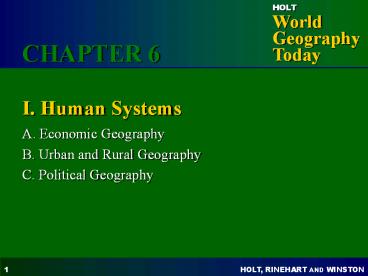I. Human Systems - PowerPoint PPT Presentation
Title:
I. Human Systems
Description:
CHAPTER 6 I. Human Systems A. Economic Geography B. Urban and Rural Geography C. Political Geography * * Objectives: What are the three main types of economic systems? – PowerPoint PPT presentation
Number of Views:179
Avg rating:3.0/5.0
Title: I. Human Systems
1
I. Human Systems
CHAPTER 6
- A. Economic Geography
- B. Urban and Rural Geography
- C. Political Geography
2
Objectives
Section 1Economic Geography
- What are the three main types of economic
systems? - How are developed countries and developing
countries different?
3
1. Three types of economic systems
Section 1A. Economic Geography
- a. traditional or subsistencepeople make goods
for themselves and their families - b. marketfree enterprise, in which people choose
what to buy and sell - c. commandgovernment makes major economic
decisions
4
2. Differences in levels of development
Section 1Economic Geography
- a. Developed countries
- i. high levels of industrialization
- Ii. high standards of living, education, and
health care - Iii. good infrastructure, with global market
economies - Developing countries
- poorer nations, with lower standards of living,
education, and health care - based mainly on farming, with fewer jobs in
services or manufacturing - includes most of Africa, Asia, Central and South
America, Pacific islands
5
Objectives
B. Urban and Rural Geography
- How have people used land throughout human
history? - How does urban geography describe human
settlements? - What are some of the ways people use land in
rural areas?
6
Using the land
Section 2Urban and Rural Geography
- for hunting and gathering
- for agriculture
- for cities
7
2. Urban geography
Section 2Urban and Rural Geography
- a. Urban geography describes urban settlements in
various ways
- i. location
- ii. size and distribution
- iii. land use
- iv. urban problems
8
Rural land use
Section 2Urban and Rural Geography
- The key economic activity is agriculture.
- subsistence
- market-oriented
- Rural land is also used for forestry, mining, and
recreation.
9
Objectives
Section 3Political Geography
- How are government and geography connected?
- What are three main types of geographic
boundaries? - How do conflict and cooperation affect
international relations?
10
The study of government is an important aspect of
geography.
Section 3Political Geography
- This includes
- how governments divide and control Earths
surface - how governments rule their people
- how governments interact
- how culture influences government
11
Types of geographic boundaries
Section 3Political Geography
- naturalbased on physical features
- culturalbased on culture traits
- geometricbased on regular, geometric patterns
12
Role of conflict and cooperation in international
relations
Section 3Political Geography
- Conflict divides countries, often over issues of
nationalism or political and economic
differences. - Cooperation helps solve political and economic
problems and bring countries together.































